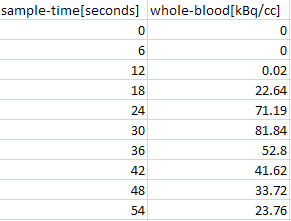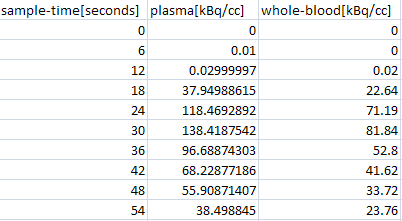Import of Blood Data
PET tracers are usually applied by intra-venous injection and then brought to the tissue of interest by circulation. Often, a part of the tracer may be bound to red blood cells. Another part may be processed in organs and end up as labeled metabolites circulating in blood plasma. The remaining category of tracer in plasma is the unchanged (authentic) tracer (parent) which is available for exchange with tissue and represents the input curve relevant for modeling.
In PKIN, the following four types of blood data are supported to model the contributions of the different forms of tracer in blood to the expected PET signal:
- The concentration of all forms of tracer in Whole Blood samples: As the average signal from a VOI always contains a fraction of signal from blood vessels and capillaries, the concentration in whole blood is needed for modeling the blood content in the expected PET signal.
- The concentration of all forms of tracer in plasma (Plasma Activity) : Although the unchanged tracer in plasma is required as the input curve of the models, it is common practice to measure the tracer activity of the whole plasma sample.
- The fraction of unchanged ligand in plasma (Parent Fraction): As a result of the metabolite analysis of plasma samples, the relative concentrations of the unchanged tracer and the metabolites are known. This information is represented by the ratio of unchanged tracer to total tracer. This fraction is expected to start with a value of 1 at the time of injection (all tracer is unchanged), and gradually decreases as the metabolites build up. Since plasma analysis is often experimentally complex and therefore error-prone, it is advisable to fit a smooth curve to the measured parent fraction.
- The Plasma Fraction: An alternative to using the measured plasma activity is the use of the ratio of plasma activity to whole blood activity, called the "Plasma Fraction". If the plasma fraction is known it can be multiplied with the whole blood activity to obtain the plasma activity. For tracers without metabolites this obviates the need for the actual blood analysis.
Whole Blood and Plasma Activity
The whole blood and plasma activity concentrations must be prepared in text files, and can be loaded using Load Whole Blood Activity and Load Plasma Activity from the Kinetic menu. Such text files with the blood data can be prepared for example in MS Excel and then saved as tab-delimited or csv separated text files. There are two variants of the format:
- Separate files for whole blood and plasma activity. In this case separate files are prepared with a header line, the sample time in the first column and the sample value in the second column as illustrated below:


- A composite file containing both whole blood and plasma activity. Note that in this case the keywords sample-time, plasma and whole-blood are required to define the meaning of the columns.

Plasma and Parent Fractions
The plasma and parent fractions need to be prepared in a similar file

and loaded using Load Plasma/WB Fraction or Load Fraction/Parent from the Kinetic menu.
Notes:
1. If no whole blood data is loaded into PKIN, the plasma concentration is used for blood spillover correction.
2. If the activity of unchanged tracer in plasma is loaded instead of the total plasma activity, no correction with the parent fraction is required. No further action is required in this case, because per default it is assumed that the parent fraction equals the constant of 1.
3. There are models which require two input curves, and in principle models with up to 10 input curves can be handled in PKIN. For these models the loading sub-menues contains appropriately labeled entries.



